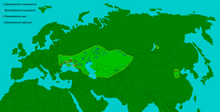
Back إلاسموثيريم Arabic Elasmoteri Azerbaijani Еласмотерии Bulgarian Elasmoteri Catalan Nosorožec jednorohý Czech Elasmotherium German Ρινόκερος του Καυκάσου Greek Elasmotherium Basque تکشاخ سیبری Persian Elasmotherium Finnish
| Elasmotherium Temporal range: Late Miocene to Late Pleistocene,
| |
|---|---|

| |
| Reconstructed E. caucasicum skeleton, Azov Museum of History, Archaeology and Palaeontology | |
| Scientific classification | |
| Domain: | Eukaryota |
| Kingdom: | Animalia |
| Phylum: | Chordata |
| Class: | Mammalia |
| Order: | Perissodactyla |
| Family: | Rhinocerotidae |
| Subfamily: | †Elasmotheriinae |
| Genus: | †Elasmotherium J. Fischer, 1808[1] |
| Type species | |
| †Elasmotherium sibiricum | |
| Other Species | |
| |

| |
| Approximate range map for Elasmotherium | |
| Synonyms | |
| |
Elasmotherium is an extinct genus of large rhinoceros endemic to Eurasia during Late Miocene through to the Late Pleistocene, with the youngest reliable dates around 39,000 years ago. It was the last surviving member of Elasmotheriinae, a distinctive group of rhinoceroses separate from the group that contains living rhinoceros (Rhinocerotinae).[2]
Five species are recognised. The genus first appeared in the Late Miocene in present-day China, likely having evolved from Sinotherium, before spreading to the Pontic–Caspian steppe, the Caucasus and Central Asia.[3] The best known Elasmotherium species, E. sibiricum, sometimes called the Siberian unicorn,[4] was the size of a mammoth and is often conjectured to have borne a single very large horn. However, no horn has ever been found, and other authors have conjectured that the horn was likely much smaller. Like all rhinoceroses, elasmotheres were herbivorous. Unlike any other rhinos and any other ungulates aside from some notoungulates, its high-crowned molars were ever-growing, and it was likely adapted for a grazing diet. Its legs were longer than those of other rhinos and were adapted for galloping, giving it a horse-like gait.
- ^ "Elasmotherium". PaleoBiology Database: Basic info. National Center for Ecological Analysis and Synthesis. 2000. Retrieved 23 March 2011.
- ^ Cite error: The named reference
Kosintsev2018was invoked but never defined (see the help page). - ^ Schvyreva, A.K. (August 2015). "On the importance of the representatives of the genus Elasmotherium (Rhinocerotidae, Mammalia) in the biochronology of the Pleistocene of Eastern Europe". Quaternary International. 379: 128–134. Bibcode:2015QuInt.379..128S. doi:10.1016/j.quaint.2015.03.052.
- ^ Kosintsev, Pavel; et al. (2019). "Evolution and extinction of the giant rhinoceros Elasmotherium sibiricum sheds light on late Quaternary megafaunal extinctions". Nature Ecology and Evolution. 3 (1): 31–38. Bibcode:2018NatEE...3...31K. doi:10.1038/s41559-018-0722-0. hdl:11370/78889dd1-9d08-40f1-99a4-0e93c72fccf3. PMID 30478308. S2CID 53726338.
© MMXXIII Rich X Search. We shall prevail. All rights reserved. Rich X Search